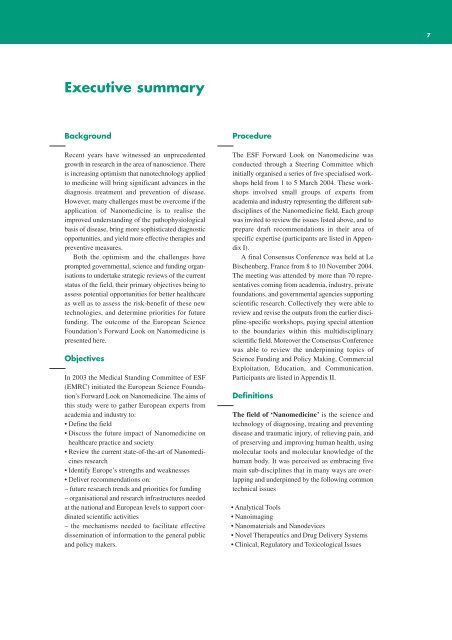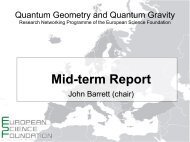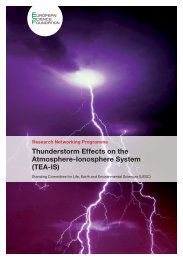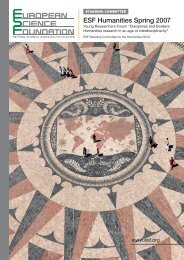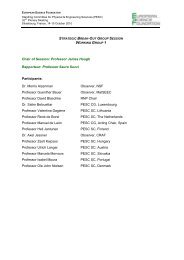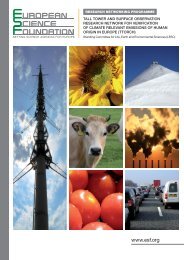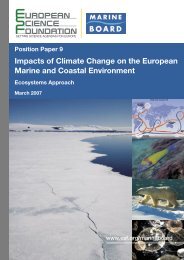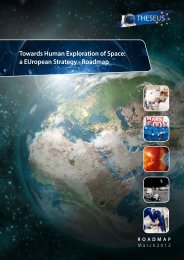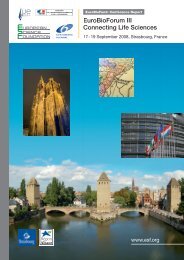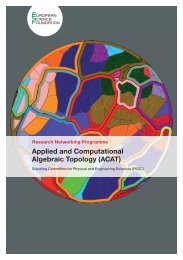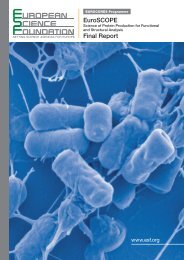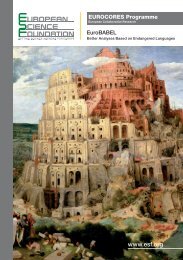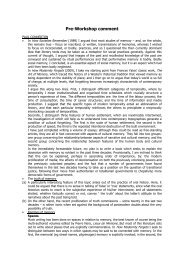Nanomedicine - European Science Foundation
Nanomedicine - European Science Foundation
Nanomedicine - European Science Foundation
Create successful ePaper yourself
Turn your PDF publications into a flip-book with our unique Google optimized e-Paper software.
7<br />
Executive summary<br />
Background<br />
Recent years have witnessed an unprecedented<br />
growth in research in the area of nanoscience. There<br />
is increasing optimism that nanotechnology applied<br />
to medicine will bring significant advances in the<br />
diagnosis treatment and prevention of disease.<br />
However, many challenges must be overcome if the<br />
application of <strong>Nanomedicine</strong> is to realise the<br />
improved understanding of the pathophysiological<br />
basis of disease, bring more sophisticated diagnostic<br />
opportunities, and yield more effective therapies and<br />
preventive measures.<br />
Both the optimism and the challenges have<br />
prompted governmental, science and funding organisations<br />
to undertake strategic reviews of the current<br />
status of the field, their primary objectives being to<br />
assess potential opportunities for better healthcare<br />
as well as to assess the risk-benefit of these new<br />
technologies, and determine priorities for future<br />
funding. The outcome of the <strong>European</strong> <strong>Science</strong><br />
<strong>Foundation</strong>’s Forward Look on <strong>Nanomedicine</strong> is<br />
presented here.<br />
Objectives<br />
In 2003 the Medical Standing Committee of ESF<br />
(EMRC) initiated the <strong>European</strong> <strong>Science</strong> <strong>Foundation</strong>’s<br />
Forward Look on <strong>Nanomedicine</strong>. The aims of<br />
this study were to gather <strong>European</strong> experts from<br />
academia and industry to:<br />
• Define the field<br />
• Discuss the future impact of <strong>Nanomedicine</strong> on<br />
healthcare practice and society<br />
• Review the current state-of-the-art of <strong>Nanomedicine</strong>s<br />
research<br />
• Identify Europe’s strengths and weaknesses<br />
• Deliver recommendations on:<br />
– future research trends and priorities for funding<br />
– organisational and research infrastructures needed<br />
at the national and <strong>European</strong> levels to support coordinated<br />
scientific activities<br />
– the mechanisms needed to facilitate effective<br />
dissemination of information to the general public<br />
and policy makers.<br />
Procedure<br />
The ESF Forward Look on <strong>Nanomedicine</strong> was<br />
conducted through a Steering Committee which<br />
initially organised a series of five specialised workshops<br />
held from 1 to 5 March 2004. These workshops<br />
involved small groups of experts from<br />
academia and industry representing the different subdisciplines<br />
of the <strong>Nanomedicine</strong> field. Each group<br />
was invited to review the issues listed above, and to<br />
prepare draft recommendations in their area of<br />
specific expertise (participants are listed in Appendix<br />
I).<br />
A final Consensus Conference was held at Le<br />
Bischenberg, France from 8 to 10 November 2004.<br />
The meeting was attended by more than 70 representatives<br />
coming from academia, industry, private<br />
foundations, and governmental agencies supporting<br />
scientific research. Collectively they were able to<br />
review and revise the outputs from the earlier discipline-specific<br />
workshops, paying special attention<br />
to the boundaries within this multidisciplinary<br />
scientific field. Moreover the Consensus Conference<br />
was able to review the underpinning topics of<br />
<strong>Science</strong> Funding and Policy Making, Commercial<br />
Exploitation, Education, and Communication.<br />
Participants are listed in Appendix II.<br />
Definitions<br />
The field of ‘<strong>Nanomedicine</strong>’ is the science and<br />
technology of diagnosing, treating and preventing<br />
disease and traumatic injury, of relieving pain, and<br />
of preserving and improving human health, using<br />
molecular tools and molecular knowledge of the<br />
human body. It was perceived as embracing five<br />
main sub-disciplines that in many ways are overlapping<br />
and underpinned by the following common<br />
technical issues<br />
• Analytical Tools<br />
• Nanoimaging<br />
• Nanomaterials and Nanodevices<br />
• Novel Therapeutics and Drug Delivery Systems<br />
• Clinical, Regulatory and Toxicological Issues


